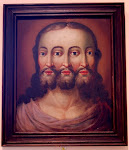Trinidad Trifacial
I have blogged about the renegade icon of the Trinidad Trifacial before, but it's always nice to find an image of it that looks so... pagan. The Church of course has never really liked this depiction of the Blessed Trinity in that it seems to blur the distinctness of the Three Divine Persons. In Peru, the Trifacial, it seems, is quite popular (there is also another depiction, this time of the Holy Trinity as three Jesuses, although the Peruvian example I saw had all Personae dressed in papal robes); the image above, however, comes from the parish of Santos Justo y Pastor in Cuenca de Campos in the Spanish province of Valladolid. It is the work of an anonymous artist and probably dates back to the end of the 16th century.
I have heard Protestants say that the God of Catholicism is a very 'sensual' God; Spanish Catholicism and its many incarnations throughout its colonies, in particular, have a way of showing this sensuality that seems almost bizarre to our modern sensibilities. Should we be uneasy? To be honest, I really don't know. My conception of God has largely been molded more on abstract principles-- proper, decent, hyper-Roman, Roman Catholicism-- to be comfortable with such an image. But at the same time, it makes 'sense'-- the kind that only Catholics schooled in the logic and riotous horizons of imagination of Catholicism since birth can appreciate-- to think of God as a three faced man. In truth, it doesn't really have to make sense, I think. It just has to be feasible. More or less.
And besides, it is certainly better than thinking of God as a robed figure with a glowing light bulb for a head. I'm looking at you, Jack Chick.


















